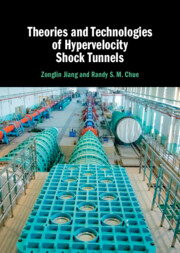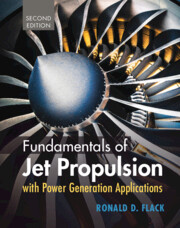Refine search
Actions for selected content:
2076 results in Aerospace engineering
14 - A Technology Leap?
-
- Book:
- Gas and Steam Turbine Power Plants
- Published online:
- 12 January 2024
- Print publication:
- 19 October 2023, pp 467-498
-
- Chapter
- Export citation
6 - Radial Equilibrium Theory
-
- Book:
- Principles of Turbomachinery in Air-Breathing Engines
- Published online:
- 18 November 2023
- Print publication:
- 19 October 2023, pp 269-297
-
- Chapter
- Export citation

Theories and Technologies of Hypervelocity Shock Tunnels
-
- Published online:
- 12 October 2023
- Print publication:
- 26 October 2023

Fundamentals of Jet Propulsion with Power Generation Applications
-
- Published online:
- 01 September 2023
- Print publication:
- 10 August 2023
-
- Textbook
- Export citation
2 - Single-Phase Flow Equations and Regimes
-
- Book:
- Fluid Dynamics of Particles, Drops, and Bubbles
- Published online:
- 28 July 2023
- Print publication:
- 17 August 2023, pp 35-83
-
- Chapter
- Export citation
3 - Governing Equations for an Isolated Spherical Particle
-
- Book:
- Fluid Dynamics of Particles, Drops, and Bubbles
- Published online:
- 28 July 2023
- Print publication:
- 17 August 2023, pp 84-129
-
- Chapter
- Export citation
Index
-
- Book:
- Fluid Dynamics of Particles, Drops, and Bubbles
- Published online:
- 28 July 2023
- Print publication:
- 17 August 2023, pp 548-552
-
- Chapter
- Export citation
6 - Single-Phase Turbulent Flow
-
- Book:
- Fluid Dynamics of Particles, Drops, and Bubbles
- Published online:
- 28 July 2023
- Print publication:
- 17 August 2023, pp 222-285
-
- Chapter
- Export citation
9 - Drag Force on an Isolated Particle
-
- Book:
- Fluid Dynamics of Particles, Drops, and Bubbles
- Published online:
- 28 July 2023
- Print publication:
- 17 August 2023, pp 398-446
-
- Chapter
- Export citation
1 - Introduction to Multiphase Fluid Dynamics
-
- Book:
- Fluid Dynamics of Particles, Drops, and Bubbles
- Published online:
- 28 July 2023
- Print publication:
- 17 August 2023, pp 1-34
-
- Chapter
- Export citation
Contents
-
- Book:
- Fluid Dynamics of Particles, Drops, and Bubbles
- Published online:
- 28 July 2023
- Print publication:
- 17 August 2023, pp v-x
-
- Chapter
- Export citation
8 - Multiphase Flow Numerical Approaches
-
- Book:
- Fluid Dynamics of Particles, Drops, and Bubbles
- Published online:
- 28 July 2023
- Print publication:
- 17 August 2023, pp 354-397
-
- Chapter
- Export citation
Appendix
-
- Book:
- Fluid Dynamics of Particles, Drops, and Bubbles
- Published online:
- 28 July 2023
- Print publication:
- 17 August 2023, pp 518-518
-
- Chapter
- Export citation
Frontmatter
-
- Book:
- Fluid Dynamics of Particles, Drops, and Bubbles
- Published online:
- 28 July 2023
- Print publication:
- 17 August 2023, pp i-iv
-
- Chapter
- Export citation
11 - Particle Interactions with Walls and Other Particles
-
- Book:
- Fluid Dynamics of Particles, Drops, and Bubbles
- Published online:
- 28 July 2023
- Print publication:
- 17 August 2023, pp 476-517
-
- Chapter
- Export citation
Preface
-
- Book:
- Fluid Dynamics of Particles, Drops, and Bubbles
- Published online:
- 28 July 2023
- Print publication:
- 17 August 2023, pp xi-xi
-
- Chapter
- Export citation
5 - Coupling Regimes for Multiphase Flow
-
- Book:
- Fluid Dynamics of Particles, Drops, and Bubbles
- Published online:
- 28 July 2023
- Print publication:
- 17 August 2023, pp 192-221
-
- Chapter
- Export citation
Nomenclature
-
- Book:
- Fluid Dynamics of Particles, Drops, and Bubbles
- Published online:
- 28 July 2023
- Print publication:
- 17 August 2023, pp xiii-xx
-
- Chapter
- Export citation
10 - Lift, Added-Mass, and History Forces on a Particle
-
- Book:
- Fluid Dynamics of Particles, Drops, and Bubbles
- Published online:
- 28 July 2023
- Print publication:
- 17 August 2023, pp 447-475
-
- Chapter
- Export citation
4 - Particle Sizes, Shapes, and Trajectories
-
- Book:
- Fluid Dynamics of Particles, Drops, and Bubbles
- Published online:
- 28 July 2023
- Print publication:
- 17 August 2023, pp 130-191
-
- Chapter
- Export citation
